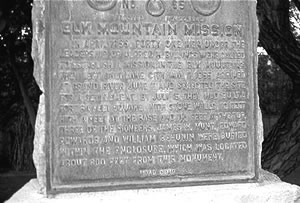Ill
Fated Elk Mountain Mission was
Established 150 Years Ago
by Jeff Richards
One hundred fifty years ago,
in 1854, pioneer settlers first came to the Moab Valley
when Brigham Young, the territorial governor of Utah and
president of the LDS (Mormon) Church, directed a group of
a dozen men to establish a major control point on the Old
Spanish Trail in southeastern Utah.

The 12 men crossed the trail northwest of the Green River
crossing, then later headed down Moab Canyon and had to
lower their wagons about 25 feet by rope down the steep
“jumping off” point, which was near the entrance
to modern-day Arches National Park. Shortly after fording
the mighty Grand River (renamed the Colorado River in 1921),
they established a temporary camp in the valley where the
city of Moab is now located. The men then left their wagons
and made their way to the present-day Utah-Colorado border,
just east of the neighboring La Sal Mountains (which were
known as the Elk Mountains back then).
Then, the following year, on May 7, 1855, a total of 41
men whose names had been called during the April 1855 general
conference of the church left Salt Lake City for the purpose
of establishing the Elk Mountain Mission at the north end
of “Little Grand Valley” (now known as Spanish
Valley). They were led by Alfred Billings. The group, accompanied
by about 75 head of cattle, followed essentially the same
trail as the previous year’s group had (which made
use of the historic Old Spanish Trail). However, travel
was slow, with two full days required to cross the Green
River alone.
By July 15, 1855, the men had arrived at their destination
and had constructed a stone fort 64 feet square, near where
modern-day Highway 191 meets the northern Moab city limits
(the fort’s walls were near the edge of the current
Motel 6 motel parking lot). They also built a corral, planted
various crops, and tried to establish friendships with the
Ute Indian tribe, whose territory covered a large part of
southern Utah and who were led by the powerful Chief Wakara
(also called Walker). Another chief named Arapeen, who was
Wakara’s brother, oversaw many of the Utes who lived
in the area, and a Ute chief known as Chief St. John was
the local leader of the Ute band that frequented the Grand
Valley area. The area had traditionally been used as a prime
common ground for gathering and trading among the Native
Americans, particularly the Utes and the Navajos.
Initially the Mormon missionaries found success, and baptized
over a dozen Utes. However, many of the tribesmen were apparently
confused about the motives of the new settlers, and tensions
between the tribe and the missionaries grew. By early fall,
it had become increasingly difficult to keep the peace.
On Sept. 20, Billings wrote in his journal that the Indians
had been stealing the just-maturing crops from the ground
during the night. “The Natives are Stealling every
chance they Get they stolen and carred off all our melons
Squashes,” he wrote, adding that potatoes and turnips
had also been taken. Three days later, on Sept. 23, 1855,
things finally escalated to the point where one of the missionaries,
James W. Hunt, was shot and killed by Ute called Charles
(a son of Chief St. John), about a mile from the fort. A
fierce gun battle then ensued at the fort, and two more
missionaries who were returning from hunting in the mountains
(Edward Edwards, and William Behunin) were also ambushed
and slain. Two or three Utes were also killed and several
were seriously wounded during the fight at the fort. The
hay and cornfields surrounding the fort were also set ablaze
by the attackers.
The next morning, the remaining missionaries abandoned the
fort, packing what they could, and abandoning five horses
and 25 head of cattle. On their way back to Salt Lake, the
missionaries were assisted by a group of friendly Indians
(reportedly led by an unnamed brother of Charles), who managed
to bring back a few of the abandoned cattle to the group,
and also saw to it that the bodies of the dead missionaries
left behind received a proper burial. According to the historical
marker now located near the Moab Area Chamber of Commerce
building at 805 North Main, all three missionaries were
buried within the walls of the fort. The plaque has been
moved from its original location, so it no longer is correct
where it says that the fort was located 800 feet away.
The demise of the Elk Mountain Mission marked one of the
rare failures for a Mormon settlement during the church’s
widespread colonization of the West under President Brigham
Young. For more than two decades afterward, no permanent
settlers lived in the Moab area. The return of permanent
settlers didn’t happen until 1877, when prospector
William Granstaff and a trapper known as “Frenchie”
arrived in the Spanish Valley area and moved into the old
fort itself. Granstaff grazed his cattle in the nearby canyon
that bears his name (Negro Bill Canyon). Within a few years,
several other ranchers had begun to settle in the area.
The town of Moab was platted in 1884 and a post office was
established. Grand County was created by the Utah Territorial
Legislature in 1890, and Moab Town was officially incorporated
on Dec. 30, 1902.
 Moab
Historic Happenings March 2004
Moab
Historic Happenings March 2004